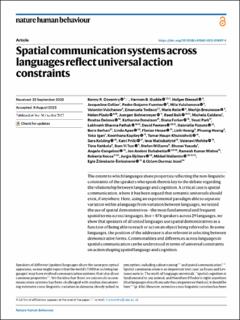| dc.contributor.author | Coventry, Kenny R. | |
| dc.contributor.author | Gudde, Harmen B. | |
| dc.contributor.author | Diessel, Holger | |
| dc.contributor.author | Collier, Jacqueline | |
| dc.contributor.author | Guijarro-Fuentes, Pedro | |
| dc.contributor.author | Vulchanova, Mila Dimitrova | |
| dc.contributor.author | Vulchanov, Valentin Ivanov | |
| dc.contributor.author | Todisco, Emanuela | |
| dc.contributor.author | Reile, Maria | |
| dc.contributor.author | Breunesse, Merlijn | |
| dc.contributor.author | Plado, Helen | |
| dc.contributor.author | Bohnemeyer, Juergen | |
| dc.contributor.author | Bsili, Raed | |
| dc.contributor.author | Caldano, Michela | |
| dc.contributor.author | Dekova, Rositsa | |
| dc.contributor.author | Donelson, Katharine | |
| dc.contributor.author | Forker, Diana | |
| dc.contributor.author | Park, Yesol | |
| dc.contributor.author | Pathak, Lekhnath Sharma | |
| dc.contributor.author | Peeters, David | |
| dc.contributor.author | Pizzuto, Gabriella | |
| dc.contributor.author | Serhan, Baris | |
| dc.contributor.author | Apse, Linda | |
| dc.contributor.author | Hesse, Florian | |
| dc.contributor.author | Hoang, Linh | |
| dc.contributor.author | Hoang, Phuong | |
| dc.contributor.author | Igari, Yoko | |
| dc.contributor.author | Kapiley, Keerthana | |
| dc.contributor.author | Haupt-Khutsishvili, Tamar | |
| dc.contributor.author | Kolding, Sara | |
| dc.contributor.author | Priiki, Katri | |
| dc.contributor.author | Mačiukaitytė, Ieva | |
| dc.contributor.author | Mohite, Vaisnavi | |
| dc.contributor.author | Nahkola, Tiina | |
| dc.contributor.author | Tsoi, Sum Yi | |
| dc.contributor.author | Williams, Stefan Daniel | |
| dc.contributor.author | Yasuda, Shunei | |
| dc.contributor.author | Cangelosi, Angelo | |
| dc.contributor.author | Dunabeitia Landaburu, Jon Andoni | |
| dc.contributor.author | Mishra, Ramesh Kumar | |
| dc.contributor.author | Rocca, Roberta | |
| dc.contributor.author | Šķilters, Jurģis | |
| dc.contributor.author | Wallentin, Mikkel | |
| dc.contributor.author | Žilinskaitė-Šinkūnienė, Eglė | |
| dc.contributor.author | Incel, Ozlem Durmaz | |
| dc.date.accessioned | 2023-11-30T15:09:08Z | |
| dc.date.available | 2023-11-30T15:09:08Z | |
| dc.date.created | 2023-11-10T14:13:18Z | |
| dc.date.issued | 2023 | |
| dc.identifier.citation | Nature Human Behaviour. 2023, . | en_US |
| dc.identifier.issn | 2397-3374 | |
| dc.identifier.uri | https://hdl.handle.net/11250/3105476 | |
| dc.description.abstract | The extent to which languages share properties reflecting the non-linguistic constraints of the speakers who speak them is key to the debate regarding the relationship between language and cognition. A critical case is spatial communication, where it has been argued that semantic universals should exist, if anywhere. Here, using an experimental paradigm able to separate variation within a language from variation between languages, we tested the use of spatial demonstratives—the most fundamental and frequent spatial terms across languages. In n = 874 speakers across 29 languages, we show that speakers of all tested languages use spatial demonstratives as a function of being able to reach or act on an object being referred to. In some languages, the position of the addressee is also relevant in selecting between demonstrative forms. Commonalities and differences across languages in spatial communication can be understood in terms of universal constraints on action shaping spatial language and cognition. | en_US |
| dc.language.iso | eng | en_US |
| dc.publisher | Nature | en_US |
| dc.rights | Navngivelse 4.0 Internasjonal | * |
| dc.rights.uri | http://creativecommons.org/licenses/by/4.0/deed.no | * |
| dc.title | Spatial communication systems across languages reflect universal action constraints | en_US |
| dc.title.alternative | Spatial communication systems across languages reflect universal action constraints | en_US |
| dc.type | Peer reviewed | en_US |
| dc.type | Journal article | en_US |
| dc.description.version | publishedVersion | en_US |
| dc.source.pagenumber | 0 | en_US |
| dc.source.journal | Nature Human Behaviour | en_US |
| dc.identifier.doi | 10.1038/s41562-023-01697-4 | |
| dc.identifier.cristin | 2195142 | |
| cristin.ispublished | true | |
| cristin.fulltext | original | |
| cristin.qualitycode | 2 | |

